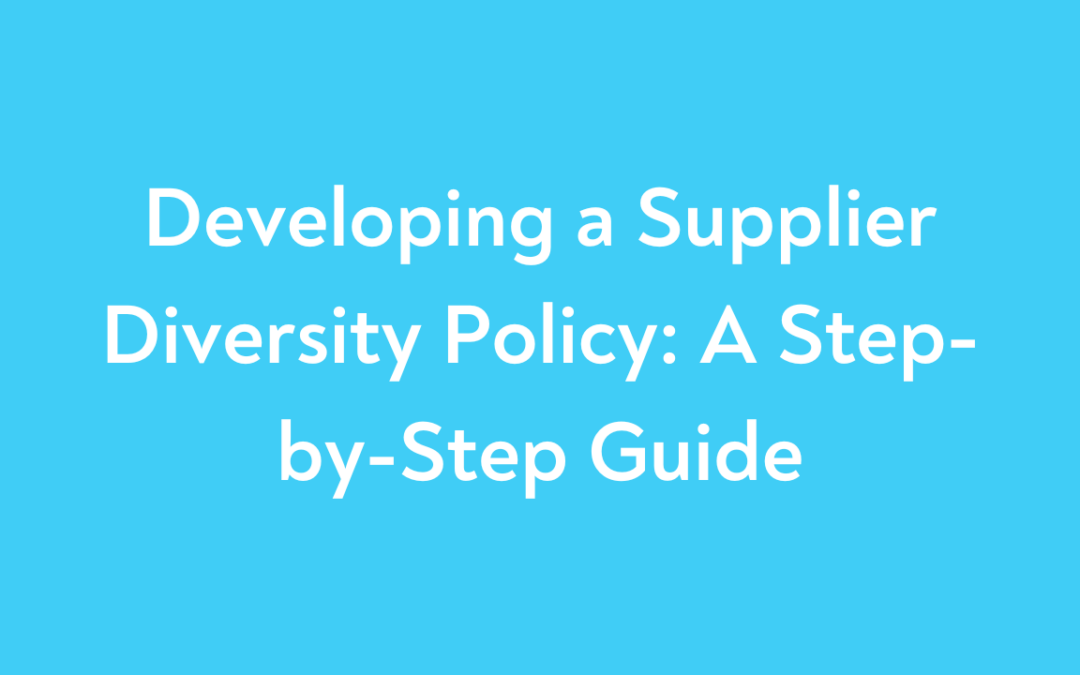Establishing a supplier diversity policy is a pivotal step for any organization seeking to foster inclusivity, stimulate economic growth, and drive innovation. Such a policy not only strengthens your supply chain but also resonates with your customers, employees, and stakeholders who share your values. This article outlines a step-by-step guide on how to build, implement, maintain, and uphold a supplier diversity policy.
Step 1: Understand the Importance of Supplier Diversity
Before diving into policy creation, it’s essential to understand the importance of supplier diversity. This involves recognizing how engaging with diverse suppliers can contribute to economic inclusivity, social responsibility, innovation, and business growth. Aligning these benefits with your organization’s mission and goals can help gain buy-in from your team and stakeholders.
Step 2: Secure Top-Down Commitment
For a supplier diversity policy to be successful, commitment from top management is crucial. The leadership team should understand and support the initiative, as they can facilitate the resources and influence needed for implementation. Expressing this commitment publicly can also help to set the tone for the entire organization and its partners.
Step 3: Define What ‘Diverse Supplier’ Means
“Diverse supplier” can refer to businesses owned by minorities, women, LGBTQIA+ individuals, veterans, or disabled people, among others. However, definitions may vary based on industry, region, and organization size. Be clear about what supplier diversity means in the context of your organization to ensure your policy is actionable and measurable.
Step 4: Set Clear Goals and Objectives
Outline clear, realistic goals for your supplier diversity policy. These could include spending targets with diverse suppliers, or numbers of diverse suppliers to onboard within a given timeframe. Goals should align with your broader business objectives and be designed to drive progress over time.
Step 5: Develop and Document Your Policy
Create a document detailing your policy, including its purpose, definition of diversity, goals, and guidelines for implementation. The document should also specify how the policy aligns with your company’s values and business strategy. It can be helpful to seek legal counsel to ensure the policy adheres to all relevant laws and regulations.
Step 6: Implement Your Policy
Implementing the policy requires integrating it into procurement processes and broader business operations. This could involve adjusting procurement protocols, training staff, and investing in supplier discovery tools like Hire Ground. Clear communication to all stakeholders, both internal and external, is crucial during this phase.
Step 7: Monitor and Maintain Compliance
Regularly reviewing your policy’s implementation is key to maintaining compliance. This can involve tracking spending with diverse suppliers, monitoring procurement practices, and ensuring the policy is being upheld across the organization. Any discrepancies should be addressed promptly to uphold the integrity of the policy.
Step 8: Review and Improve Your Policy
As with any business strategy, your supplier diversity policy should evolve over time. Regular reviews can help identify areas for improvement and adjust goals as necessary. Incorporating feedback from staff, suppliers, and stakeholders can also help ensure your policy remains relevant and impactful.
Building a supplier diversity policy is just the beginning. Maintaining and upholding this policy requires ongoing effort, commitment, and flexibility. By developing and implementing a robust supplier diversity policy, you’re not only enhancing your own business operations but also contributing to a more inclusive and equitable business landscape.
Key Takeaways:
- Understanding the Importance of Supplier Diversity: Recognizing the benefits of supplier diversity, such as economic inclusivity, social responsibility, and innovation, is the first step towards creating a successful policy.
- Securing Top-Down Commitment: A supplier diversity policy can only succeed with the support of top management. Leadership must understand and endorse the initiative to provide the necessary resources and influence.
- Defining ‘Diverse Supplier’: Clear definitions of what constitutes a diverse supplier within the context of your organization are essential for making the policy actionable and measurable.
- Setting Clear Goals and Objectives: Goals, such as spending targets with diverse suppliers or the number of diverse suppliers to onboard, should align with broader business objectives and be designed to track progress over time.
- Developing and Documenting Your Policy: Create a detailed document that outlines your policy’s purpose, diversity definitions, goals, and implementation guidelines. Legal counsel can ensure your policy adheres to all relevant laws and regulations.
- Implementing Your Policy: Integrate the policy into your procurement processes and wider business operations. Clear communication with all stakeholders is key during this phase.
- Monitoring and Maintaining Compliance: Regularly review the implementation of your policy by tracking spending with diverse suppliers, monitoring procurement practices, and ensuring the policy is being upheld consistently.
- Reviewing and Improving Your Policy: Your supplier diversity policy should evolve over time. Regular reviews and feedback incorporation can keep your policy relevant and impactful.


Recent Comments